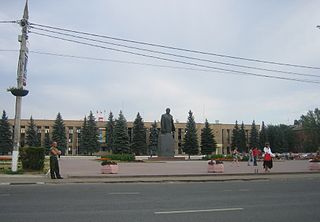
As of the 2021 census, the population of Russia was 147.2 million. It is the most populous country in Europe, and the ninth-most populous country in the world, with a population density of 8.5 inhabitants per square kilometre. As of 2020, the overall life expectancy in Russia at birth was 71.54 years.

A metropolitan area or metro is a region consisting of a densely populated urban agglomeration and its surrounding territories which are sharing industries, commercial areas, transport network, infrastructures and housing. A metropolitan area usually comprises multiple principal cities, jurisdictions and municipalities: neighborhoods, townships, boroughs, cities, towns, exurbs, suburbs, counties, districts and even states and nations in areas like the eurodistricts. As social, economic and political institutions have changed, metropolitan areas have become key economic and political regions.

Udmurtia, officially the Udmurt Republic, is a republic of Russia located in Eastern Europe. It is administratively part of the Volga Federal District. Its capital is the city of Izhevsk.

An urban area is a human settlement with a high population density and an infrastructure of built environment. This is the core of a metropolitan statistical area in the United States, if it contains a population of more than 50,000.

The Kurdish population is estimated to be between 30 and 45 million. Most Kurdish people live in Kurdistan, which today is split between Iranian Kurdistan, Iraqi Kurdistan, Turkish Kurdistan, and Syrian Kurdistan.

Domodedovo is a city in Moscow Oblast, Russia, located 37 kilometers (23 mi) south of the capital Moscow. The population estimated in different years are 152,404 (2021 Census); 96,145 (2010 Census); 54,080 (2002 Census); 55,294 (1989 Soviet census).. The increase of population is due to the merger of three neighboring inhabited localities into the town in 2004.

A metropolis is a large city or conurbation which is a significant economic, political, and cultural area for a country or region, and an important hub for regional or international connections, commerce, and communications.

Throughout most of its history, Istanbul has ranked among the largest cities in the world. By 500 CE, Constantinople had somewhere between 400,000 and 500,000 people, edging out its predecessor, Rome, for world's largest city. Constantinople jostled with other major historical cities, such as Baghdad, Chang'an, Kaifeng and Merv for the position of world's most populous city until the 12th century. It never returned to being the world's largest, but remained Europe's largest city from 1500 to 1750, when it was surpassed by London.
Accurate or reliable data for historical populations of Armenians is scarce, but scholars and institutions have proposed estimates for different periods.

Oktyabrsky District is one of the four urban districts of Tomsk, Tomsk Oblast, Russia. It is the largest district of Tomsk by land area, occupying 126 square kilometers of land on the northeast of the city. As of the year 2021, its total population is 181,422.









